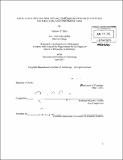Magic angle spinning NMR applied to membrane protein 2D crystals : the structure and function of VDAC
Author(s)
Eddy, Matthew T. (Matthew Thomas)
DownloadFull printable version (34.18Mb)
Alternative title
Magic angle spinning Nuclear Magnetic Resonance applied to membrane protein 2D crystals : the structure and function of VDAC
Magic angle spinning NMR : methodology and application of the membrane protein VDAC
Other Contributors
Massachusetts Institute of Technology. Dept. of Chemistry.
Advisor
Robert G. Griffin.
Terms of use
Metadata
Show full item recordAbstract
Membrane proteins mediate critical functions in biological systems and are important drug targets for a number of diseases. Determining the three-dimensional structure and function of membrane proteins under physologically relevant conditions is a long sought-after goal in structural biology. In pursuit of this objective we have applied Magic Angle Spinning Nuclear Magnetic Resonance (MAS NMR) to investigate the structure and function of the 32 kDa human integral membrane protein VDAC, the Voltage Dependent Anion Channel. Our results on VDAC have relied on a number of improvements in NMR methodology described in this thesis. These new methods include '3C-' 3C and 5N- 3C recoupling experiments optimized for measuring long-range homonuclear and heteronuclear restraints at high magnetic field strengths and spinning frequencies. We also describe precise 13C-33C distance measurements used to define a protein hydrophobic core. Novel methods for processing nonuniform sampling are presented as well as optimized sampling schedules for faster data acquisition. This new methodology is extended first from small peptides to a microcrystalline preparation of GB 1, a 56 residue globular protein. Methods are then extended to the much larger membrane protein VDAC. This thesis then presents structural and functional characterization of VDAC in lipid bilayer two-dimensional (2D) crystals. A strategy combining specific isotopic labeling with advanced 3D heteronuclear experiments enabled assignment of a large extent of the primary sequence. Extensive assignments of VDAC in lipid bilayers permitted comparison of VDAC's secondary structure between lipid bilayers and detergent micelles. MAS NMR experiments were paired with temperature dependent 2H NMR and DSC experiments to investigate protein-lipid interactions in the 2D crystals. Functional studies performed on the same samples used for NMR showed proper channel gating. To assess the function of VDAC we characterize its pH dependence as well as a phosphorylation mimetic.
Description
Thesis (Ph. D.)--Massachusetts Institute of Technology, Dept. of Chemistry, 2012. "June 2012." Vita. Cataloged from PDF version of thesis. Includes bibliographical references.
Date issued
2012Department
Massachusetts Institute of Technology. Department of ChemistryPublisher
Massachusetts Institute of Technology
Keywords
Chemistry.